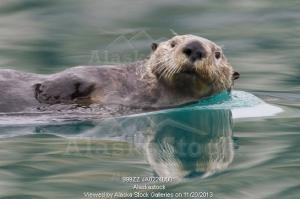Sale on canvas prints! Use code ABCXYZ at checkout for a special discount!

The Sea Otter has been a significant part of Alaska's history since Vitus Bering's first voyage of discovery to Alaska in 1742. When Bering returned to Russia, he brought back and reported on the rich furs of the sea otter which began a huge and profitable fur trade to primarily the Chinese. The Russians recognized that the harvesting of the sea otter in such great numbers would eventually decimate the animals and had began instilling protective laws for the sea otter. It's argued that the depletion of the sea otter in the mid-nineteenth century may have led to Russia's sale of Alaska in 1867. Once the US purchased Alaska, the early attempt by the Russians to protect the otters were dropped, and the sea otter was almost driven to extinction. In 1911 an international treaty was made against harvesting of the sea otter. In 1972, the Marine Mammal Protection Act transferred management authority to the U.S. Fish and Wildlife. Recovery of the Alaska sea otter population has been dramatic. Perhaps as few as 2,000 total animals existed in 1911, but by the mid-1970s the Alaska population numbered between 110,000 and 160,000. Today, the sea otter is considered fully recovered
What led to the popularity of the sea otter is its rich, luxurious fur which consists of a dense underfur of inch long fibers and a second lay of protective "guard hairs." The guard hairs can vary in color from brown to a silver-like color. Older sea otters tend to have white whiskers and the "silver" guard hairs increase on the head. This appearance has caused the sea otter to be given the nickname of "Old Man of the Sea." The sea otter also produces body oil that during grooming, the otter spread over his fur and provides "waterproofing." The sea otter does not have a layer of blubber to protect it from the cold but rather relies upon the thick fur for warmth. However, if the fur becomes dirty and contaminated with soil or substances such as petroleum, the fur loses its ability to insulate and the sea otter becomes vulnerable to hypothermia.
The sea otter is actually a part of the weasel family of which the river otter and mink also belong. The sea otter can go ashore, but due to short and stiff feet, it is often clumsy. Because of this, the sea otter seldom is seen on land and rarely more than 100 yards from shore. The short and stiff feet, however, do allow the sea otter to deftly handle food and even use simple "tools" to eat such foods as sea urchins, crabs, clams, mussels, octopus, fish, and other marine invertebrates. They usually dive to the bottom in 5 to 250 feet of water and return with several pieces of food, roll on their backs, place the food on their chests and eat it piece by piece using their forepaws and sometimes a rock to crack shells. In the wild, sea otters never eat on land. The search for food is one of the most important daily activities of sea otters, as large amounts are required to sustain the animal in healthy condition. Feeding dives generally last less than one minute although some otters are capable of staying underwater for five minutes or more. Captive animals require a daily food intake equal to one-quarter of their body weight. In order to obtain the 8 to 15 pounds of solid food needed, an otter may have to bring up 40 to 50 pounds of whole shellfish.
Otters can mate during any time of the year and give birth during any season. However, in Alaska, it is most common to have pups born in the spring. Sea otters give birth to only one pup at a time. Sea otters do not migrate unless food becomes scarce. Female and males often will congregate in separate gender groups. Eagles will occasionally prey upon the pups and Orca whales have been known to take adult otters, but the sea otters' predators are limited. However, as in times past, human impact is perhaps the most significant threat. The Exxon Valdez oil spill dramatically demonstrated the effects of oil contamination on sea otters. More than 1,000 carcasses were found after the spill, and it is likely that the total number that died was several times greater. Thus, while sea otters are flourishing in Alaska's waters, it is clear that they are susceptible to human activities.
Find more photos of Sea Otters at Alaska Stock: www.alaskastock.com/resultsframe.asp?akfacts=1&txtkeys1=sea%20otter